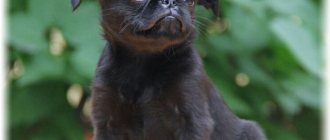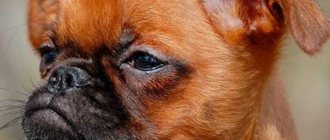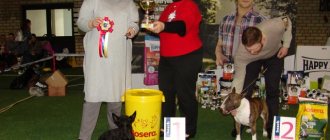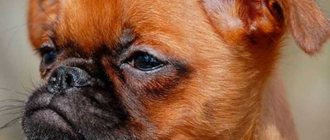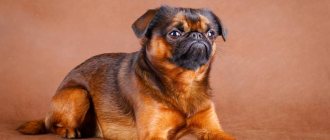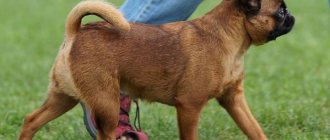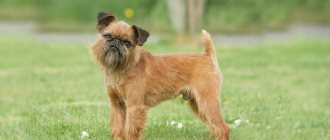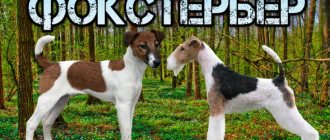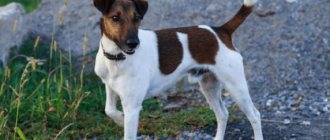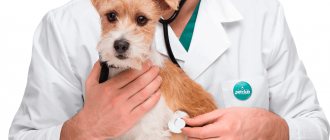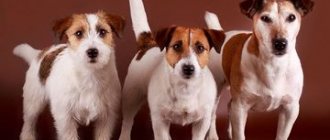Thanks to Belgian breeders, several varieties of the Griffon breed were born, the name of which, translated from French, means “wiry-haired”. Although the Petit Brabançon is a short-haired dog and is different from its relatives, it also falls into this category. The animal has many other names: Brabant Griffon, Petite Brabançon, Smooth-haired Griffon, etc.
Description of the Petit Brabançon breed
Popularity 42nd among 263 dog breeds
Lifespan:
12-15 years
Breed group:
Decorative
Height:
16-26 cm
Country of origin:
Belgium
Average price:
20-40 thousand rubles
Weight:
3-6 kg
Latest articles Cat health
Rabies vaccination for cats: choice of vaccine, necessity, schedule 01/22/2022 4 0 0
Selection and adaptation
TOP 20 best cat breeds for families with children 01/22/2022 25 0 0
Griffon food
If caring for these dogs itself is not difficult and has no subtleties, then special attention should be paid to the nutrition of griffons.
It is generally accepted that a special diet is the lot of service dogs, and pets can eat the same things that people eat. This is one of the significant misconceptions.
The natural eating habits of dogs and humans are very different. Dogs are predators by origin, close relatives of wolves, foxes and jackals.
Humans are omnivorous primates by origin, whose diet in the natural environment is still based on plant foods.
Dogs, of course, will eat what people eat. If only because people's food has great flavor.
Switching to a diet that is not typical for the natural processes of the body is fraught with various disturbances in the functioning of the digestive system. In addition, problems with metabolism may appear, which leads to excess weight gain and obesity.
The other extreme is switching only to dry food or special canned dog food. No one, especially dogs, can live on freeze-dried and canned foods.
Key facts
The Petit Brabançon, or Brabant Griffon, is a curious and sociable dog that is not characterized by groundless aggression. The pet is not vindictive, loves children, and since its intelligence corresponds to the level of development of a three-year-old child, this dog will be an excellent playmate. The characteristics of the Brussels Griffon breed also say that he is not jealous and accepts other animals in the family well.
The Brabant Griffon is very attached to the family and, in particular, to its owner, whose mood is easily read. He is always ready to console if the owner is upset and rejoices with him. This breed does not tolerate being transferred to another family or even being left in foster care very well. If possible, take your dog with you on your trip.
The description of the Petit Brabançon breed says that the dogs are easy to care for and have good health. These dogs love to be the center of attention and are great companions. The life expectancy of the Petit Brabançon is long and can reach up to 15 years.
Puberty and mating
Female Petit Brabançons reach sexual maturity at 8–10 months, and males at 10–11 months. However, mating can be carried out after 2-3 heats in the female, at about 1.5 years. Until this time, the dog’s body is not ready to bear offspring, since the risk of pathologies in puppies or complicated pregnancy in the female is high. Males that are too young have immature sperm, so pregnancy may not occur, or developmental defects will also be present.
Important! You should only look for a pair of Petit Brabançons in a nursery. Professional breeders conduct DNA tests to select individuals without hereditary diseases, which they will pass on to their offspring. Petit Brabançons cannot be crossed with other breeds, as their children will lose their unique properties and will be sickly.
Petit Brabançons can occur with similar breeds, such as the Brussels Griffon, Belgian Griffon. After such mating, healthy, future fertile puppies are obtained, with new unique qualities.
If the dog owner does not intend to breed, it is better to contact the clinic for castration or sterilization. The first procedure involves the removal of the genital organs, and the second involves the cessation of sexual function without surgery. After it is carried out, the dog becomes calmer, more balanced, and does not try to run away in search of a sexual partner.
Important! Castration is carried out from 6 to 12 months. The duration of the operation (under anesthesia) is 15–20 minutes. After it, you need to provide the dog with proper care to avoid complications.
It is unacceptable to use sexual suppressants in the form of tablets, powders and drops, as they have many contraindications (for example, diseases of the genitourinary system, cancer, too young an age). They also increase appetite, increase body weight, and negatively affect hormonal levels. Such drugs (especially with long-term use) can cause diabetes mellitus, atrophy of the adrenal cortex, and various pathologies of the genitourinary and endocrine systems.
History of the origin of Petit Brabançon
The history of the breed dates back to Europe in the 15th century. Small dogs were called “stable griffons” and were engaged in catching mice and rats in stables. Thanks to their flexible, cheerful and non-conflict disposition, griffons captivated the nobility, including the royal circle, and quickly moved to the silk cushions of palaces and carriages. In particular, members of the Belgian royal family were great admirers of griffins.
Petit Brabançons were first presented at the exhibition in 1880, where they received recognition from the audience and excellent marks from the judges. After this, the breed quickly became popular, but, unfortunately, the quality of the livestock was sacrificed to quantity.
It is unknown what would have happened to the breed if Maria Henriette, the Queen of Belgium, had not been its great admirer. She put a lot of effort into purebred dogs, and they were successful. By crossing breeds, different types of wool were obtained - hard in Griffons and smooth in Petit Brabançon. The muzzle of these dogs is inherited from the Affenpinscher, and the Cavalier King Charles Spaniels took part in the coloring.
In the 20th century, the Belgian government allowed foreigners to purchase puppies and export them outside the country. During the Second World War, Petit Brabançons, like many breeds, were exterminated, as a result of which the population greatly decreased and became endangered. Thanks to the fact that individuals were preserved in England and the USA, breeders managed to restore the breed, slightly changing the exterior. Corrections and additions were made to the standard twice - in 1963 and in 2003. Now the appearance of Petit Brabançons is so familiar that it is difficult to imagine that they once looked different.
Despite the proximity of Europe and Russia, the first Brabant Griffons came to us from the USA only in 1993. The first Petit Brabançon kennel was founded in St. Petersburg and was named “Nevsky Hobbit”, and a little later the breed found its way to Moscow. In 1999, the number of Russian Petit Brabançons was 85 dogs.
Health
Representatives of the breed have good health. With proper care, they rarely get sick. The average life expectancy of Petit Brabançons is 13-14 years.
Diseases
Due to their physiological characteristics, Petit Brabançons often have eye problems. Therefore, it is important to maintain hygiene, and at the first signs of illness, take the animal to the veterinarian. Also, the Griffon dog breed is prone to respiratory tract pathologies. In the heat, pets begin to choke, and in winter they easily catch colds.
Vaccinations
Caring for the initial vaccination of a griffon puppy falls on the shoulders of the breeder. Healthy animals are vaccinated at 2 months of age from:
- carnivore plague;
- parvovirus enteritis;
- viral hepatitis;
- leptospirosis;
- parainfluenza;
- coronavirus.
After 2-3 weeks, the puppies are given a second injection. Vaccinations against rabies are given to dogs at six months of age. In the future, adult animals are revaccinated annually. Pets are also regularly wormed and treated for fleas and ticks.
The animal's vaccination schedule can be adjusted in accordance with the prevalence of certain diseases in a certain region and the conditions under which the dog is kept. The decision to change the vaccination schedule can only be made by a specialist.
Appearance of Petit Brabançon
General impression
Petit Brabançons are small “pocket” dogs with a fairly strong bone structure and strong build for their size. In the photo, the Petit Brabançon is eccentric, but at the same time it is a very harmonious dog. The standard for Petit Brabançons is the same, and “mini” and “standard” individuals are just a trick of unscrupulous breeders who sell purebred crosses or simply want to increase the price.
Head
The head is harmonious in relation to the body, despite its rather large size. The large forehead turns into a clear stop. The muzzle is of very moderate length, which is no more than 1.5 cm, ending with an upturned nose not lower than the eyes.
The lips are tightly closed, the lower jaw is wider than the upper, quite rounded. Bite – snack. The cutters must be complete.
The eyes are not protruding, but set far apart from each other, round and large. Eye color is dark brown, good if the whites are not visible.
The ears are small, set wide and high. If the ears are cropped, then they stand, and undocked ears are semi-dropping. The disadvantage is that the ears are too large. The nose is wide and always black.
Neck
The neck is of medium length, smoothly blending into the withers and shoulders.
Torso
A body that fits neatly into a square, with a short straight back, a fairly short loin and a slightly sloping croup that is in no way narrow. The chest is deep and wide, visually protruding slightly forward. The bottom line is taut.
Forelegs
The forelimbs with strong bones are set wide and parallel, and the elbows are tucked. The paws are round, evenly set, with compressed but not fused toes. The pads are soft, preferably dark in color. The claws are preferably black.
Hind limbs
The hind limbs are also parallel, with developed muscles and good bones. The angulations are well defined, the hocks are noticeably dropped. There should be no dewclaws on the paws.
Tail
The tail is most often docked by one third, set high and carried upward. If the tail is not docked, then the tip is directed towards the back, but is not curled or thrown over the back.
Movements
The movements are powerful and parallel, with a confident push. Ambling is a fault, as is throwing up the forelimbs.
Wool
The coat is very short, no longer than 2 cm in the most combed places. It is dense and shiny, moderately tough. Unlike griffons, Brabançons have a smooth muzzle without a brush.
Color
Petit Brabançon colors can be black, fawn, or mixed. The black color comes with red, red or fawn patches. One mandatory requirement remains - a dark mask on the face for any color.
Dimensions
The height of the Petit Brabançon at the withers is allowed from 16 to 26 cm, and the weight of the Petit Brabançon is determined in the range from 3.5 to 6 kg. Dimorphism is moderately pronounced, females are slightly shorter and lighter than males. Males should not suffer from cryptorchidism; both testicles are in the scrotum. In general, the size of the Petit Brabançon should not be too large.
Breed standard
The Petit Brabançon breed first standardized in the first half of the 20th century, more precisely in 1904. Later, experts made changes to the accepted parameters of the exterior of its representatives. Finally, in 2003, the final decision was made to standardize the “griffon”.
The body of the animal is wide and square. The limbs are widely spaced. The claws on the paws are short, black, and very sharp. The dog has a strong muscular back and a wide chest. The bottom of the lumbar region is slightly inclined.
The front legs are much shorter than the hind legs. On the front of the body, thick skin folds into a lush withers. There are several folds of skin on the sternum. These dogs are born with a long tail. According to the standard, it is docked by 2/3 of the part. It has the shape of a saber, is located high on the lower back, and can be twisted.
As for the neck, it is not at all expressed in this animal. The head is small and round in shape. The muzzle is flattened. The most prominent part of the head is the eyes. They stick out a little, round and dark. There are short cilia above them. The dog's ears are small, thickened at the base. Semi-hanging. Previously, according to the standard, they should have been docked. Today this is not necessary.
There is a clear undershot in the jaw - the lower teeth are located in front, and the upper teeth, respectively, in the back. The lips are pressed tightly to the gums, the mouth is closed. The dog is not drooling. Her lips are dry. Petit Brabançon is often depicted in photographs as peaceful and calm.
This impression is quite consistent with his character. This animal has strong muscles, it gives the impression of being strong and resilient. The height at the withers of a baby griffon varies from 17 to 24 cm.
Character of Petit Brabançon
Petit Brabançons are very sociable and become attached to their owner and family. Their muzzle has pronounced facial expressions, the dog’s mood and emotions are easy to read, they are almost human.
Petit Brabançons are excellent companions for children; they are smart, playful, unforgiving and non-aggressive. They get along well with other animals, birds and rodents.
The Brabant Griffon loves to be the center of attention, he loves guests and company. People, in turn, are also usually fascinated by the canine gentleman. This little dog is full of self-esteem, has a developed mind and courage.
Representatives of this breed have a very difficult time being separated from their owners, so it is better to take your Brabançon with you on trips and travels. If this is not possible, it is better not to take the Brabant for foster care, but to invite home a person you know well, with whom it will be easier for the dog to survive the period without owners.
Petit Brabançons prefer to sleep with their owner, preferably under the same blanket. This breed is not gibberish and will not annoy neighbors with non-stop barking. An undoubted advantage of the Petit Brabançon's character is the ability to adapt to the lifestyle and mood of the owner.
The Brabant Griffon happily walks outside, but you can train him to go to the toilet at home in a litter tray or on a diaper. In winter, these kids get cold outside, so it’s better to warm them up by wearing overalls.
Brabançons live exclusively at home, and probably no one would think of keeping these little ones in an enclosure. They feel good both in an apartment and in a country house.
Who is the breed suitable for? Thanks to its small size and wonderful character, the Petit Brabançon can be recommended to almost everyone, with the exception of people whose work involves frequent or long-term business trips.
Key points in training
Even decorative dogs need to be trained. You need to start from birth. The puppy must understand who is boss in the house, what can and cannot be done. There are several rules to establish a hierarchy:
- Ban on playing on human furniture;
- Begging is prohibited; feeding takes place only after the family gets up from the table;
- A person enters the house first;
- Barking without reason is punished;
- The owner is always the authority.
A spoiled puppy will be difficult to re-educate at an older age. From 3 months, babies are trained in a targeted manner. They start with simple commands, remembering the name, daily routine. Kennel clubs recommend completing the “Dog in the City” program. It turns on all the necessary signals, they will help the pet navigate the city space and make walks safe.
Read about how to properly train a dog in the article: “Training a puppy: effective methods from dog handlers, learning commands at home.”
By six months the dog should know its name and basic commands:
- "sit";
- "place";
- "near";
- "it is forbidden";
- "voice".
Pettit needs mental training. Therefore, after learning all the necessary words, they switch to visual signals or a whistle.
It is forbidden to use brute force in education. The best method is still considered motivational - stimulation with goodies and toys.
Education and training
Despite its size, the Petit Brabançon needs training. The well-developed qualities of the breed will turn a well-mannered Brabant into a wonderful companion.
Raising and training the Petit Brabançon is easy due to its high intelligence and quick wit. He learns clear commands well. It is vitally important to accustom the puppy to the commands “Come”, “Fu”, “Near”. Mastering the discipline requires some amount of repetition of the exercises. Pleasant commands like “Walk” and “Eat” are learned easily and quickly and do not require any special training.
Brabançons are trained using the carrot and stick method. The carrot is delicacy and praise, and the stick is the dissatisfied tone and look of the owner. The “carrot” should be given out only after the exercise has been performed correctly. Miniature dogs should not be physically punished.
Representatives of this breed easily pass the mini-OKD, which differs from the usual one in the distance between the pet and the owner. Brabant Griffons can also participate in sports competitions, in particular agility.
A well-mannered and trained pet is a wonderful friend and part of the family.
Pros and cons of the breed
Petit Brabançons have the following positive qualities:
- kindness, affection for the owner and his family;
- friendliness with other people;
- lack of conflict when in contact with other pets;
- empathy - empathy for a person’s emotional state;
- lack of rancor;
- bravery;
- playfulness;
- great sympathy for children;
- high intelligence and quick learner;
- quick adaptation to conditions of detention;
- ease of care.
Breeders highlight the following disadvantages of the breed:
- intolerance of loneliness, reluctance to listen to strangers, severe stress;
- an irresistible desire to hunt small animals, as well as pick up objects from the ground;
- lack of security and guard qualities;
- high price.
Due to its character traits and ease of care, the Petit Brabançon can be recommended as a first dog. It is perfect for a family with children. Elderly people will also be able to raise and care for the dog, and will also get a lot of pleasure from communicating with it.
Those who spend most of their time at work or frequently travel should avoid buying a Petit Brabançon. They are not suitable for people who see their future pet as a guard and protector. Also, Petit Brabançons (and all other breeds) are contraindicated for people with unstable mental health.
Health and disease of Petit Brabançon
Possible diseases
Petit Brabançon enjoys good health. A healthy dog lives and pleases its owners for a long time. However, there are diseases that representatives of this breed are prone to:
- Retinal atrophy, which impairs vision and can lead to complete blindness.
- Proptosis, in other words, prolapse of the eyeball.
- Distichiasis is an abnormal growth of eyelashes, which can cause blepharospasm, conjunctivitis, and in severe cases, deep ulcerative lesions of the eyeball.
- Turn of the century.
- Diseases of the oral cavity and teeth - cleft palate, simultaneous growth of milk and permanent teeth.
- Tendency to infectious and colds.
- Skin diseases, although Brabançons are not prone to allergies.
- Dislocation of the kneecap.
- Obesity.
Puppies and adult dogs must receive vaccinations on time, before which dogs are wormed two weeks before. An unvaccinated puppy should avoid contact with other dogs. Petit Brabançons need good care, proper feeding, and disease prevention.
Reproductive health
Petit Brabançons can be bred with Brussels and Belgian Griffons, but the genetics of color inheritance must be taken into account. Therefore, if you are not an amateur owner, it is better to breed Petit Brabançons with Petit Brabançons so that the color of the puppies is not affected.
Brussels Griffon bitches are bred no earlier than the second or third heat. Before breeding, the bitch must be vaccinated and treated against parasites, and must also attend at least one exhibition and receive a rating of at least “very good.” choir." You should not breed an overweight bitch - pregnancy and childbirth are very difficult for her. It is better to wait with the mating and keep the girl on a diet for a while. Animals must be bred with documents and without defects, otherwise sterilization will be the best solution.
Mating is carried out in the middle of estrus, on days 9-14. Within two days, a second – control – mating is usually carried out.
If pregnancy has occurred, then there are from 56 to 72 days left before the birth of the offspring. Pregnancy can be confirmed after 4-5 weeks by ultrasound. In the second half of pregnancy, the bitch requires increased nutrition. The dog should exercise a lot so as not to gain excess weight, which could interfere with childbirth.
There can be up to 4-5 puppies in one litter. Childbirth in this breed often involves complications, so it is better to enlist the help of a veterinarian or an experienced breeder who will be present at the birth. The life of the puppies and the bitch herself depends on timely assistance.
Socialization
Early socialization is important for Belgian Smooth Griffon puppies. Then the dog will grow up intelligent, courageous and self-confident. As soon as quarantine ends after the first vaccinations, children begin to be actively introduced to the world around them.
Animals are raised in a playful way: persistently, but without unnecessary severity. Even in childhood, it is necessary to establish the correct hierarchy: Belgian smooth-haired griffons strive for leadership no less than large dogs. If you do not show the puppy his place in the pack, problems will inevitably arise in the future.
Petit Brabançons enjoy playing with children. However, it is necessary to explain to the child that a dog is not a toy. The pet will not tolerate disrespectful treatment. Despite his modest dimensions, he should not be squeezed when he doesn’t want to be, or pulled by his ears and tail.
The smooth-haired griffon does not conflict with its relatives. A warm friendship often develops between a dog and a cat. But representatives of the Petit Brabançon breed cannot tolerate rodents. This is a manifestation of the instinct inherent in all Belgian Griffons.
Features of feeding and diet
The little native of Brabant is picky when it comes to food, and it is almost impossible to feed him something he doesn’t want to eat. Your pet needs to purchase a bowl on a stand or adjustable bracket so that his posture does not deteriorate. You need to feed your dog at the same time, after a walk, and do not give it more food than normal, remembering its tendency to obesity.
Puppies up to 6 months of age continue to have 4-5 meals a day, and by 10-12 months of age, 2 feedings remain, just like an adult dog.
It seems more rational to feed the dog with ready-made industrial food. They do not need to be cooked, it is easy to maintain calorie standards, and no additional intake of vitamin complexes or dietary supplements is required. The food must be at least premium or holistic.
Carefully read the composition of the feed - the meat component should come first, and not in the form of meat and bone meal, but in the form of meat and offal. The food should be suitable for small breeds, that is, it should consist of small granules.
The natural diet of a Petit Brabançon should include lean meats as a base, cereals and cereals, vegetables, some fruits, eggs, fermented milk products, and sometimes boneless sea fish fillets, shrimp, and squid can be given.
You cannot feed your pet:
- fatty meat and lard;
- river or bony fish;
- fried, spicy, salty;
- sweets and flour;
- bones, especially tubular ones;
- legumes, potatoes.
As a treat, you can please your pet with low-fat varieties of cheese, special treats that are sold in pet stores, boiled liver, heart or tripe. Treats should not be substituted for feeding.
Puppy care
It is important to choose a place in the puppy’s home so that he is comfortable and does not disturb anyone. You cannot place an impromptu booth on the passage from room to room or near the entrance doors or exit to the balcony. You should not place your dog in rooms with tiled floors or close to heating appliances.
It is important to remove or hide all electrical wires. The same applies to small objects that a puppy can swallow, and chemicals.
In order for the puppy to quickly adapt to a new place, it is recommended to ask the breeder for bedding with the smell of the mother. It can be put in a dog house.
Petit Brabançon puppies should eat the appropriate food:
- lean meat;
- sea fish without bones;
- porridge with water (buckwheat, rice, oatmeal);
- milk and milk-based products;
- raw chopped vegetables and fruits;
- greenery.
The food is supplemented with vegetable oil and boiled eggs. The puppy must be given vitamin or mineral supplements.
You should not give smoked, pickled or confectionery products. It is worth giving up salty, fried, fatty foods. Bird bones are prohibited for consumption.
After each meal, the puppies are taken outside to relieve themselves and get used to cleanliness. You can only play after the dog has gone to the toilet.
The owner must be prepared for the fact that “piles” or wet puddles may appear on the floor. There must be a tray in the room, and the floor around it can be covered with moisture-resistant diapers. You cannot scream or hit the baby if he relieves himself on the floor. It is worth keeping an eye on him and taking him outside on time or putting him on a diaper near the litter box.
A Petit Brabançon puppy needs to be brushed daily. It is enough to wash it 2-3 times a month after heavy contamination. For washing, use special dog or baby shampoos.
You need to start raising a baby from the first days of his appearance in the house.
Care and maintenance
Keeping and caring for the Petit Brabançon is simple. If the hair bothers you, one or two brushes per week or a little more often during shedding is enough. Washing the dog should be infrequent, when dirty or before shows. You need to be especially careful when washing your dog in winter. The wet Brabançon should be taken to the room in a towel and dried with a hairdryer. You should not leave drying to chance, let an undried pet run through drafts or walk on the street, remembering their tendency to catch colds. This breed does not require cutting or grooming.
The ears are cleaned once a week with a cotton pad and hydrogen peroxide. If you feel an unpleasant odor, too much wax, something is gurgling in the ear, or the dog is shaking its head, then contact the veterinary clinic - these could be symptoms of a variety of diseases.
The eyes are wiped in the morning to remove exudate. Pay close attention to the eyes: you need to see a doctor if there is too much exudate or it is purulent, there is increased tearing, the dog blinks frequently or the eye seems to be squinting.
Nails are trimmed once a month; for this you need to purchase a nail clipper. Petit Brabançons do not really like this procedure, but any owner can handle such a baby.
Although Brabant Griffons live at home and can go to the toilet in a litter box, communication with their relatives is very important for them, therefore, you need to walk your Petit Brabançon at least once a day. A walking area with the same small breeds is well suited. In addition, an active walk keeps the dog in good physical shape and develops its mind.
Where to buy and price
Petit Brabançons are not very common in Russia, so the initial price of a puppy is quite high and amounts to 18-25 thousand rubles. The cost of puppies from a specialized nursery can vary from 30 to 60 thousand rubles. Nurseries include:
- "Maryland" (Moscow);
- "Golden Grif" (St. Petersburg);
- "Mellis Stilla" (Ekaterinburg).
Petit Brabançons are very intelligent and calm animals, ideal for any family. They will not distract their owners from their business; it is enough for them to simply be near them. Pets have extraordinary intelligence, so they are suitable even for an inexperienced dog breeder.
Tips for choosing a puppy
You should not buy a puppy without a pedigree. Such Petit Brabançon puppies are cheaper, but they are often resold. These poor creatures are kept in poor conditions, they are taken away from their mother a month, or even earlier, often these puppies are sick. By saving on the price of a dog, you can spend an amount significantly exceeding its cost on treatment, and in the best case, you will become the owner of a sickly low-breed dog without documents, and in the worst case, the treatment will not help, and the puppy will die from an infection. In such cases, there is no one to file claims with; the puppy seller has received his money and washed his hands of it.
Choose trusted nurseries, where you can get full advice on the breed and puppies, view and check all documents. Puppies from a good breeder are clean, well-fed and active, have an RKF puppy card, a brand and a veterinary passport with their first vaccinations. They are already eating premium food, they have clean ears and eyes that look at you with curiosity.
It is better to buy Petit Brabançon puppies at the age of 2-3 months, when they are no longer breastfed and are completely ready to go to a new home.
The sex of the future pet is the owner’s choice, but both females and males have a wonderful character. Males are not dominant, but females are affectionate. Aggression is not typical for the breed, but you should not choose a timid puppy. It is very difficult to determine the quality of a puppy’s coat - the situation will become clearer when the baby grows up.
How to choose a puppy
If a Petit Brabançon puppy is healthy and does not have any congenital anomalies, he behaves actively and shows curiosity. Potential buyers should be wary of the sluggish behavior and generally sickly appearance. The same goes for discharge from your puppy's eyes or nose, dirty fur or a scratched belly, not to mention the presence of parasites. You should refuse to purchase such a copy without hesitation.
Some people are ready to buy a sick puppy in the hope of curing it, especially since breeders offer such individuals at a reduced cost. You should not be seduced and not fall for such tricks! Treatment costs can be so significant that they exceed the cost of a healthy puppy.
When choosing a future pet, buyers want to determine what the quality of its coat will be as an adult. The task is extremely difficult, but you definitely need to pay attention to the color. Petit Brabançons are characterized by bright colors from birth.
Potential owners often ask themselves: at what age can you buy a puppy of this breed? It is better to choose those who are already 2.5-3 months old. Usually by this age, breeders have already given the baby 1-2 vaccinations. But to find out for sure, be sure to check with the seller.
Mixed feeding
The most difficult option is a mixed diet. Thoughtful and conscious addition of homemade products to commercial food regulates the caloric content and energy of the diet, stimulates the appetite of picky short-haired gourmets, and increases the intensity of feelings between the dog and the owner.
In any case, such nutrition for Brabançon is possible if:
- the final diet is balanced and satisfies the dog’s needs;
- is normally digested by the griffon, without causing negative intestinal reactions;
- mixed feeding has been introduced systematically: commercial and homemade components are present in the daily menu.
Diseases
The Petit Brabançon boasts strong immunity and excellent health. With proper care, systematic prevention and vaccination, dogs practically do not get sick and happily live up to 12-13 years. They have no tendency to allergic reactions, and there are no severe hereditary diseases of the breed. If problems do occur, most often it is:
- ophthalmological diseases;
- inflammation and infections of the respiratory tract;
- susceptibility to overheating;
- difficult birth.
If you notice uncharacteristic behavior in your pet, increased tearing or inflammation of the eyes, difficulty breathing, runny nose or cough, contact your veterinarian for advice. Preventive or timely measures are always more effective than treatment. Make sure that during the hot season, the dog does not spend too much time in the sun, so that it always has enough clean, cool drinking water.
Consult the breeder and veterinarian regarding pregnancy. Perhaps the doctor will suggest delivery by cesarean section to protect the bitch from complications during natural childbirth.
Buying a puppy for a home
The appearance of a four-legged friend in the house is not a decision for a single day. When choosing it, you need to pay attention to many nuances.
Price for puppies and adult dogs
The pricing policy for Petit Brabançon puppies in Russia varies from 15 to 80 thousand rubles. It directly depends on the genetic line and pedigree regalia.
It’s easy to buy a pet for the soul, that is, without documents, for 10-15 thousand. He may be quite healthy and even charming, but his show career is prohibited.
For 20-25 thousand rubles you can buy a puppy of the “breeding class” category, with a brand and with documents, but no one guarantees its display at international exhibitions.
Elite puppies are valued at over 35 thousand rubles . The blood of parents with a rich exhibition past flows in them. Such kids are able to show themselves as Champions of exhibitions at any level.
Puppies are considered adults when they reach sexual maturity. When choosing a dog older than 8 months, you should understand that it already has certain habits and training skills of the previous owner. The price of an adult dog will undoubtedly be cheaper, from about 10 thousand rubles.
Where to buy a puppy
The main nurseries for breeding the Belgian Petit Brabançon are located in Moscow, Yekaterinburg and St. Petersburg. Except in nurseries, a Petit Brabançon puppy can be purchased from private breeders who confirm the “purity” of the puppy with appropriate documents and a brand. To avoid buying a crossbred puppy, experts advise choosing only trusted sellers, those who have positive reviews and recommendations.
What to look for when purchasing
It is advisable to pick up a Petit Brabançon puppy when it reaches three months of age, after the second vaccination. In addition to the puppy card, he must have healthy eyes, shiny fur and odorless ears. The puppy must be active and moderately well-fed.
Don't forget to check for overgrown fontanels and dewclaws. Other parameters: color, bite, muzzle shape, body, tail must also match the standard.
Exhibition conformation indicators in dogs develop at approximately 4-6 months. No breeder can give a 100% guarantee that this or that pet will grow up.
Signs of heat
During estrus, a dog's behavior often changes dramatically. Estrus can be determined by the following signs:
- bloody discharge from the loop;
- unusual activity or aggressiveness for a dog;
- sadness;
- frequent urination;
- increased attention from male dogs;
- molt.
During estrus, large breed dogs may become more aggressive. If your pet has stopped obeying normal commands and is overly excited, it is better to limit your movements around the city with him. Smaller breeds are characterized by excessive activity and playfulness.
When walking with a female dog in heat, you should be on guard. The smell of the discharge attracts males, which often causes unwanted mating. To prevent unwanted consequences, you should protect your pet from other cables.
